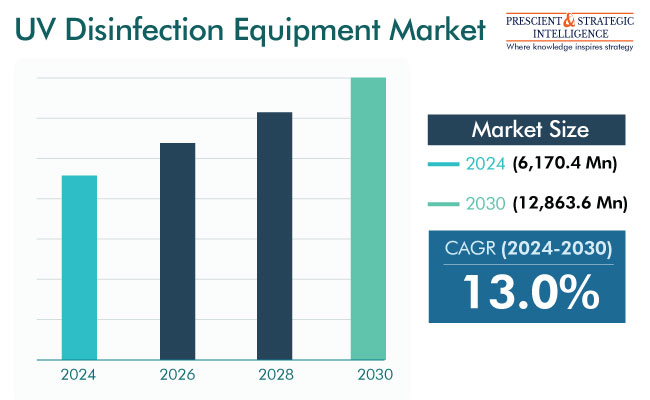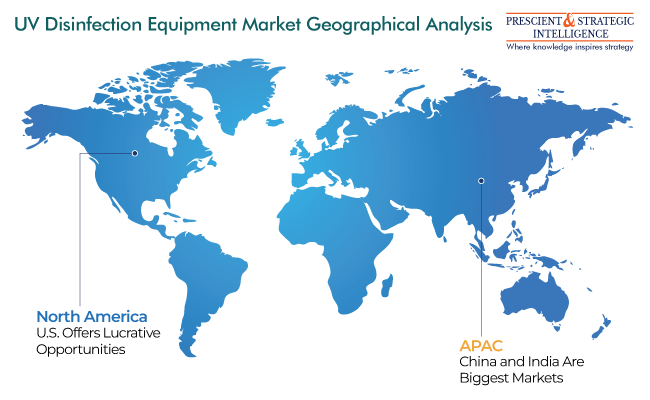Report Code: 10027 | Available Format: PDF
UV Disinfection Equipment Market Report: Size, Share, Strategic Developments, and Growth Potential Estimation, 2024-2030
- Report Code: 10027
- Available Format: PDF
- Report Description
- Table of Contents
- Request Free Sample
Market Overview
The estimated size of the ultraviolet disinfection equipment market is USD 6,170.4 Million in 2024, and it will showcase 13.0% CAGR from 2024 to 2030, to reach USD 12,863.6 Million by 2030. The increasing requirement for ultraviolet disinfection machines in healthcare establishments, rising infection control awareness in the light of the pandemic, and growing concerns over the quality of drinking water are projected to drive the market development.

UV disinfection has gained traction among public health agencies as an extremely efficient technique for processing drinking water, reclaimed water, and wastewater. Moreover, countries throughout the world have accepted these systems given their human safety, ability to save water, and no requirement for harmful chemicals.
Additionally, the growing customer knowledge of airborne infections and allergies has forced players to spend on eco-friendly technologies to reduce contamination levels throughout the world. Because of this, companies are adding technologies such as photocatalytic purification, filtration, and UV disinfection to their portfolios, to eliminate all reasons for air contamination.
Growing Usage of UV-Based Disinfection in Healthcare Sector
Ultraviolet air decontamination is a well-known method, with numerous establishments, such as the CDC and WHO, constantly encouraging its utilization in laboratories, hospitals, and colleges. Essentially, they are adopted to improve the quality of the air by eliminating particulate dust and matter, which is also thought to decrease coronavirus spread.
Hence, with the surge in COVID-19 cases, numerous infirmaries started using ultraviolet systems to purify spaces that carry a high risk of infection spread, such as general wards, clinics, operating rooms, and laboratories. Moreover, the technology has a weaker ecological impact than chlorine gas and sodium hypochlorite, as UV systems majorly use electricity.
Patient wards can be decontaminated in just 10 minutes by utilizing this technology. UVC LEDs and UV lamps can be even incorporated into the HVAC system to sanitize the air, by removing both viruses and bacteria. Already, its usage in conjunction with manual disinfection has led to a reduction in the number of patients contracting healthcare-associated infections (HAI) and related fatalities.
For instance, at the John R. Oishei Children's Hospital in New York, the deployment of the eUVGI technology in HVAC systems enabled the removal of microorganisms and an ensuing decrease in tracheal colonization within the NICU. Likewise, the ELWA Hospital and JFK Hospital in Monrovia, Republic of Liberia, have installed two TRU-D smart UVC systems to sanitize spaces where Ebola patients are being isolated.
| Report Attribute | Details |
Market Size in 2024 |
USD 6,170.4 Million |
Revenue Forecast in 2030 |
USD 12,863.6 Million |
Growth Rate |
13.0% CAGR |
Historical Years |
2017-2023 |
Forecast Years |
2024-2030 |
Report Scope |
Market Trends, Drivers, and Restraints; Revenue Estimation and Forecast; Segmentation Analysis; Impact of COVID-19; Companies’ Strategic Developments; Market Share Analysis of Key Players; Company Profiling |
Explore more about this report - Request free sample
Rising Incidence of Airborne and Waterborne Diseases
All kinds of human activities, including industrial, residential, and commercial, pollute the air and water. This, in turn, leads to waterborne and airborne diseases, both of which have become significant healthcare burdens over centuries. As per the WHO, the water supply of over 2 billion people globally is contaminated, while 6.7 million premature deaths every year result from air pollution. In recent times, these alarming statistics have forced governments, commercial entities, industrialists, and individuals to focus on air and water purification.
UV Lamps Category Is Holding Largest Revenue Share
The UV lamps category holds a major revenue share, based on component. Numerous kinds of ultraviolet lamps, including low-pressure bulbs, are utilized in for purposes where weak flows and lengthier exposure periods are required, while commercial spaces generally use amalgam lamps, as they can efficiently eliminate bacteria.
Additionally, the reactor chambers category is projected to experience a stable CAGR during the forecast period. This is because they offer a better flow, in spite of their compact size, are simple to fix, and have less than 0.5 meters of head loss.
Water and Wastewater Category Is Market Leader
The water and wastewater category is generating the highest revenue under the application segment. The fast increase in industrial production in emerging economies has caused alarming levels of water contamination. Coupled with the surge in the requirement for safe and clean drinkable water by a growing populace, this factor drives the demand for UV microbe killers in water treatment applications.
The air treatment category is also significant, as many educational institutions use technology for stopping infection spread. Most schools and colleges are in densely populated areas, which poses a high risk of air contamination. Because of this, educational establishments have begun using ultraviolet decontamination systems to reduce the spread of COVID-19 and decrease indoor air contamination.
Municipal Category Holds Significant Market Share
The municipal end user category holds a significant market share, which can be attributed to the augmenting usage of UV disinfection equipment in water and wastewater processing units in advanced economies. At municipal wastewater processing plants, this technology proves cheaper, eco-friendlier, and safer over conventional ones.
For centuries, industrial procedures and urbanization in developing countries have been causing water pollution because of the discharge of unprocessed or inappropriately processed effluents. Therefore, the chemical-free ultraviolet decontamination technology is being increasingly utilized to treat industrial wastewater.
Ultraviolet Disinfection Equipment Manufacturing Top Companies Are:
- Xylem Inc.
- Trojan Technologies Group LLC
- Halma PLC
- Calgon Carbon Corp.
- Atlantic Ultraviolet Corp.
- Evoqua Water Technologies LLC
- Advanced UV Inc.
- American Ultraviolet
- Atlantium Technologies Ltd.
- Dr. Hönle AG
- Lumalier Corp.
- Xenex Disinfection Services Inc.
- ENAQUA
- S.I.T.A. Srl
- Hitech Ultraviolet Pvt. Ltd.
North American Region Is Significant Market
North America is a key contributor to the market due to the growth of the food & beverage, pharmaceutical, automotive, and chemical industries in Canada and the U.S. This results in a high-volume expulsion of toxic effluents into waterbodies, which, in turn, drives the demand for effective water disinfection approaches.

Similarly, Europe reels under significant pollution levels because of the increasing rate of urbanization and industrialization. Additionally, the evolving vehicle sector, stringent guidelines for environmental conservation, and regional financial development are boosting the requirement for air purifiers in homes, commercial spaces, and industrial facilities.
Further, water and sewage treatment requirement is projected to grow rapidly in China, India, and other APAC countries in the future. Their governments focus strongly on industrial and municipal water purification owing to their huge populations and significant waterborne disease burden. The key priorities for scientists are creating pioneering recycling systems and enhancing the present ones.
Moreover, the increasing levels of pollution and the growing incidence of airborne diseases in Latin America have augmented customers’ awareness of air cleansing. The rising expenditure on the water and sewage treatment industry is also projected to drive the LATAM market over this decade.
Most UV Disinfection Equipment Sales Made via Direct Channels
Under the distribution channel segment, the direct category accounts for the majority of the sales. Being an emerging technology, its major users are large municipal, commercial, industrial, and institutional entities, who buy directly from the manufacturer. Moreover, these users have long-term contracts with the market players for regular purchases and comprehensive aftersales services.
Want a report tailored exactly to your business strategy?
Request CustomizationWant an insight-rich discussion with the report author?
Speak to AnalystOur dedication to providing the most-accurate market information has earned us verification by Dun & Bradstreet (D&B). We strive for quality checking of the highest level to enable data-driven decision making for you
Our insights into the minutest levels of the markets, including the latest trends and competitive landscape, give you all the answers you need to take your business to new heights
With 24/7 research support, we ensure that the wheels of your business never stop turning. Don’t let time stand in your way. Get all your queries answered with a simple phone call or email, as and when required
We take a cautious approach to protecting your personal and confidential information. Trust is the strongest bond that connects us and our clients, and trust we build by complying with all international and domestic data protection and privacy laws